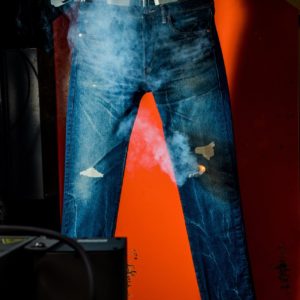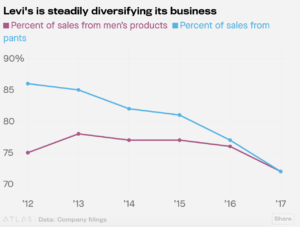Denim has long been referred to as the fabric of American lives, and Levi Strauss & Company’s plan to become publicly traded once again in early 2019 merely reinforces that point.
Although the brand Levi Strauss & Co. was hugely popular throughout the mid to late 20th century, the denim maker’s clothing started to decline in popularity in the late 1990s, causing the company to go private. Today, however, Levi’s has experienced a full comeback, with the iconic label clearly pronounced on the jeans and jean jackets of many Americans as well as consumers across the globe.
Thanks to the return of Levi’s products to mainstream fashion, the company is well-situated financially to return to public markets. In its most recent quarter, revenue grew 11%, with the entire brand delivering 12% growth over the quarter. Furthermore, the company’s women’s business grew for the 13th straight quarter. The most recent earnings report also boasted strength in the direct-to-consumer area, thanks in part to the fact that the chain opened 65 new stores over the course of the last year.
Levi Strauss & Co.’s 2017 annual report also demonstrated its strong financial position. In addition to strong net revenue, gross margin, earnings before income taxes, and free cash flow, the company reported having its lowest net debt since 2000. Source: 2017 Annual Report
But what propelled Levi Strauss to go from America’s forgotten brand to being set to issue an IPO in 2019 that will purportedly raise between $600 and $800 million, and value the company at $5 billion? First, denim’s fashionableness seems to be back, with jean jackets and bell bottom jeans being worn by many once again. In fact, the denim market is expected to reach $79 million by 2023, thanks in part to the growth and transformation of the Asian retail clothing industry. For Levi’s in particular, however, the money that the company invested in a research and development center in the early 2010s, called Eureka Innovation Lab, seems to be paying off. Levi’s recently unveiled new technology that allows it to automate new parts of the denim-making process, ranging from design to manufacturing, which not only saves time and effort, but also creates less waste and thus is more sustainable.
Levi’s now uses lasers to distress its jeans, not people. Source: Wall Street Journal
Levi’s also diversified its products by expanding its women’s wear recently, causing sales for women’s clothing to rise from $800 million a year in 2015 to over $1 billion in 2018. On top of all of those factors, it certainly helps that celebrities have come to love Levi’s, with the Kardashian family all wearing different pairs of Levi’s in their 2017 Christmas card.
The company continues to diversify its products, focusing less on men’s wear and pants. Source: Quartzy
But beyond those factors, something that has undoubtedly attracted consumers to Levi Strauss & Co. products over those of their competitors has been the company’s values. Self-described as “values-driven,” the CEO of Levi’s, Chip Bergh, has been an outspoken supporter of various highly politicized and relevant issues. In November 2016, he wrote an open letter asking gun owners not to bring their weapons into Levi’s stores after a customer was accidentally shot. Bergh has since defended the company’s gun policy and asked other business leaders to stand up against gun violence, while also taking a variety of steps including establishing the Safer Tomorrow Fund earlier this year which directs money to support nonprofits working to end gun violence. The company has also partnered with like-minded clothing maker Patagonia to create MakeTimeToVote.org, an initiative that gave employees time off to vote in the recent midterm elections also encouraged other large corporations to follow in suit. Furthermore, in late summer of 2018, the company announced its 2025 Climate Action Strategy, an aggressive and detailed plan that includes achieving 100% renewable electricity and a 90% reduction in greenhouse gas emissions at all of its factories in less than a decade.
At a time when consumers care not just about how their clothes look but also about how they were made, where the materials were sourced from, and what the seller believes in, Levi’s has managed to cultivate an ethically-minded fashion brand supported by aggressive values-driven initiatives. At the same time, the company has found increased cultural relevance, and has willingly taken the plunge into the world of automation in order to improve its processes and create better products. While other companies fear mechanization or stagnate as they try to figure out how meaningfully decrease environmental impact, Levi’s has forged a unique path for itself by embracing the current challenges posed to businesses in the modern economy. Given their carefully-devised and multi-faceted approach, it seems highly likely that Levi’s will easily raise its projected $600 million—and perhaps even more—when the time comes in 2019.



Leave a Reply
You must be logged in to post a comment.